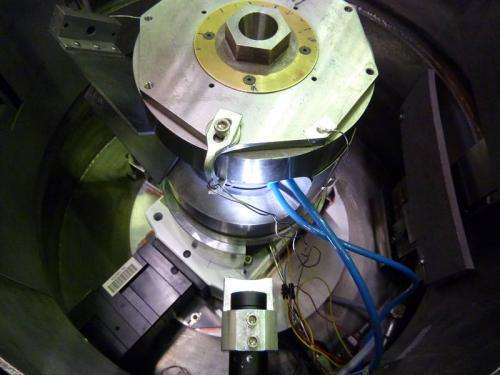New analysis of oxide glass structures could guide the forecasting of melt formation in planetary interiors

Findings from neutron diffraction studies at the Institut Laue-Langevin could also help researchers develop new tougher, high pressure commercial glasses.
Structural mapping of oxide glasses and liquids by Bath University researchers could provide a new tool to investigate the environmental conditions that melt the Earth's interior and produce volcanism at the surface. The analysis carried out using neutrons at the Institut Laue-Langevin (ILL) maps out how the tight packing of oxygen atoms under extreme pressure leads to larger-scale structural changes that affect a material's viscosity. The study published in the PNAS journal could also help predict the same property-influencing structural changes in the development of future pressure hardened commercial glasses.
An open and closed case
Under ambient conditions oxide glasses have quite an open structure. However under high pressure conditions the collapse of their atomic arrangement brings the oxygen atoms closer together. Eventually the packing of oxygen creates changes in the network structures (from four oxygen atom tetrahedral arrangements to six oxygen atom octahedral arrangements) that affect the material's bulk properties such as compressibility and viscosity which determine its flow behaviour.
As a result of this sensitivity of oxygen atoms to their surrounding environments, and the impact these structural transformations have on material's bulk properties, scientists believe close analysis of the structural arrangements could be used to gauge the conditions materials experience during their formation, as well as predict the performance of future commercial materials under extreme conditions. However an exact understanding of how pressurised conditions produce these transformations has so far been lacking.
To investigate one potential indicator of these changes Prof Salmon and his team tracked the oxygen–oxygen atom interactions within oxide glasses under extreme pressures using neutron diffraction at the Institut Laue-Langevin, the world's flagship centre for neutron science. Their analysis confirmed that the overall network structures and associated physical properties of a wide variety of disordered oxides can be categorized and therefore predicated by the material's oxygen-packing fraction (i.e. the volume in a liquid or glass structure that is occupied by oxygen atoms) which increases under pressure. This overturned previous suggestions that the oxygen number density (the number of atoms in a given volume) on its own could provide the best indication of structural change.
Prof Phil Salmon said: "Up to now there has been no reliable guide for predicting the conditions under which transformations occur. However if you have got a material and you know that the packing density is approaching the random close-packing upper limit, where 64% of the volume is taken up with oxygen, it is a strong indication you are going to get a change in structure and therefore a change in the physical properties."
New glasses
The findings of this study are important for understanding the properties of high-density liquids to aid in the design of glasses, including the potential to make glass at high pressure rather than at high temperature. While traditional glass formation involves cooling from a melt at atmospheric pressure, new glasses with interesting properties such as high hardness or extreme toughness may be attainable by forming glass under high pressure conditions instead.
"This research provides important insights into the relationship between pressure and glass structure," explains John Mauro, Manager of Glass Research at Corning Incorporated, the world's leading manufacturer of specialty glass and ceramics. "Most importantly, Prof. Salmon and his coworkers have made the link to the topology of the glass network, which is what governs many of the macroscopic properties of the glass. These insights will be very helpful if we wish to design new glasses under high pressure conditions."
The evolving Earth
There is also interest in Prof Salmon's research from the Geoscience community. Bristol University's Dr Simon Kohn studies mantle processes. He sees the data derived from neutron and x-ray analysis being used as a guide to help answer some of the most pressing questions in Geoscience and the evolution of the Earth.
"Whilst we can measure the viscosity and density of lavas at the surface, the deeper you go into the Earth the more difficult it is to measure these properties," says Dr Kohn. "Any model that can give you an idea of how melt structure and density changes with pressure is certainly interesting for understanding how our current layered internal planetary structure formed from a single giant magma ocean. Accurate answers to this question will require precise values for the density of the magma ocean materials at the time. A better understanding of how local environments within the subsurface affect viscosity is required to model the speed of turnover of magma which affects how slowly or quickly you can get heat out and therefore how quickly the ocean crystallised."
More information: Anita Zeidler, Philip Stephen Salmon, and Lawrie Basil Skinner. "Packing and the structural transformations in liquid and amorphous oxides from ambient to extreme conditions." PNAS 2014 ; published ahead of print June 30, 2014, DOI: 10.1073/pnas.1405660111
Journal information: Proceedings of the National Academy of Sciences
Provided by Institut Laue-Langevin















.jpg)




